
Hummingbird
Brotzman Farm, Laceyville, PA
August 26, 2017
Photo by Carol Brotzman
|
Settlers XXIV: Joseph Hoagland: Dutch Pioneer in Sullivan County | |
|

Hummingbird
Brotzman Farm, Laceyville, PA
August 26, 2017
Photo by Carol Brotzman
THE HOAGLANDS: FROM AMSTERDAM TO THE NEW WORLD
* * * * * * * * * * * * * * * * * * * * * * * * * * * * * * * * * * * * * * * * *
The Hoagland (Hoogland, Hoogelandt, Hooglant, Hoogelande, Hoochlandt, Hoochland, Hooglante, Hogland, Hoglin) name probably originates from the name of a locality in Holland or Prussia. Haagelant, a district of Brabant, Holland, is derived from the Dutch word haage meaning a hedge or thicket. A family of viscounts and governors has been recorded in that area. Hocherland (Oberland) was a district of ducal Prussia translated as highland, with the Dutch equivalent being hoogeland. In the thirteenth century and again in 1525, a number of residents fled from Hocherland to avoid the anger of the Teutonic Knights and settled in the Netherlands. These emigrants became known as van Hoogeland, or, from Hoogeland. There was also a village in the province of Utrecht, Holland that was called Hoogland.
From 1638 to 1658, four men with the Hoogland surname emigrated to New Netherlands: Cornelis Dircksen Hoochlandt of Amsterdam in 1638; Christoffel Hooglandt of Haarlem in 1655; Dirck Jansen Hoogland from Maerseveen in 1657; Cornelis Andrieszen Hoogland of Hague in 1658. Whether any of the four were related is unknown. It is believed that Cornelis Andrieszen Hoogland returned to Holland in 1664. Joseph Hoagland probably descends from the line of Dirck Jansen Hoogland from Maerseveen.
While searching for a northern passage to the Orient in 1609, Henry Hudson, in the service of the Dutch East India Company, sailed up the Hudson River and laid claim to New Netherlands for Holland. New Netherlands encompassed an area covering part of New York, Connecticut and northeastern New Jersey. The Dutch East India Company received a three-year charter in 1614 from the States-General of the Netherlands, giving them permission to trade in America. Fort Nassau was erected as a fort and trading post south of present day Albany. In 1617, the fort was badly damaged by a flood. The charter was not renewed for the Dutch East India Company.
The Dutch West India Company was chartered in 1621 with exclusive trading rights in the western hemisphere. Fort Orange was built near Albany in 1624. To ensure ultimate possession of the country, thirty Dutch and Walloon (inhabitants of the frontier between Belgium and France, or, possibly any Huguenot of that era) families were sent aboard the New Netherlands to the province to colonize and provide agricultural goods for the traders. Eighteen of these families settled at Fort Orange; two families and eight men settled at the second Fort Nassau, located on the Delaware at present-day Gloucester City, N.J.; two families and six men were sent to the mouth of the Connecticut River; eight men settled on Manhattan Island.
Among the settlers at Fort Orange was Joris Jansen de Rapelje, who came from New Rochelle, France and was probably a sailor. Just prior to sailing or during the voyage, he married Catalina Tricot, who was the daughter of George Tricot and was born in Paris, France in 1605. They became the parents of the first white child born in the colony. Their daughter Sarah Rapelje was born at Fort Orange June 9, 1625.
Joris and Catalina had the following children:
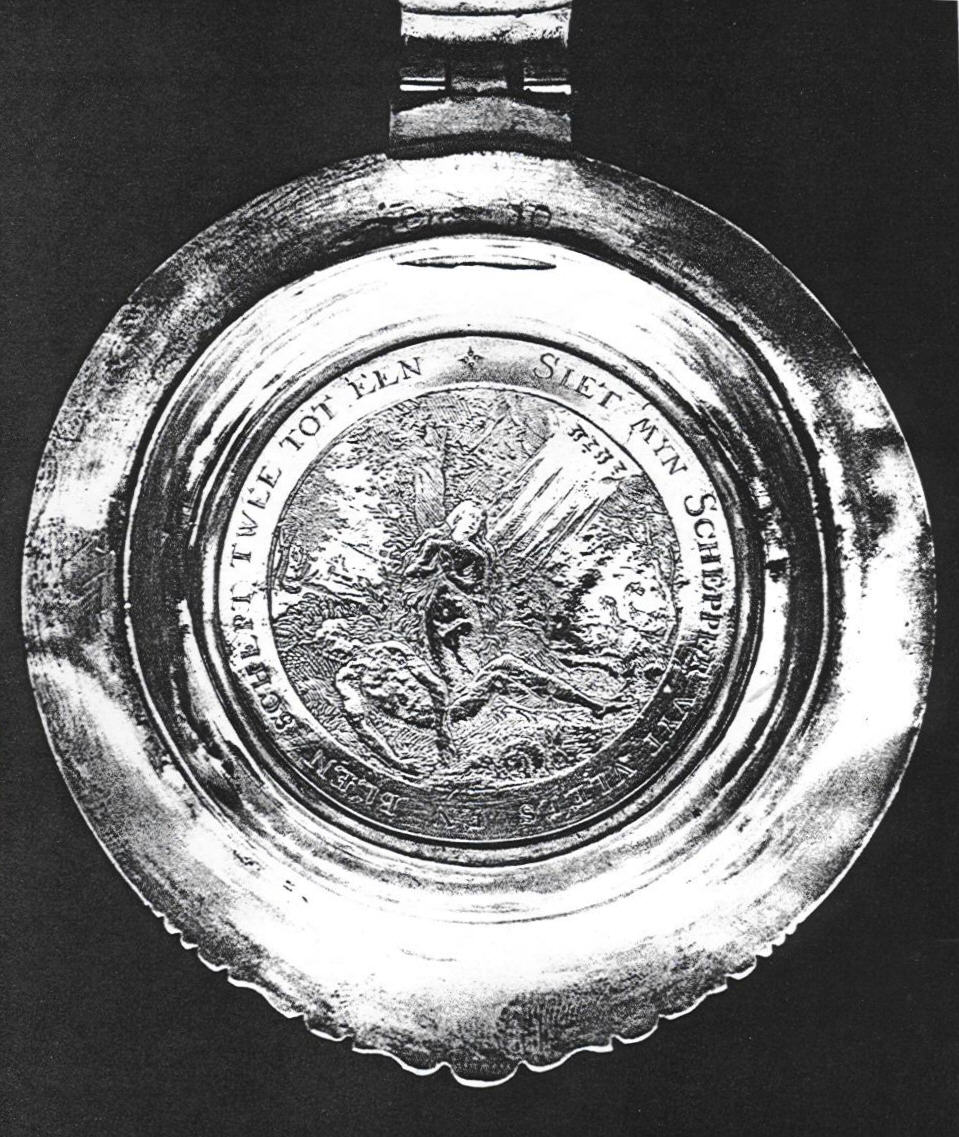
Marriage medal given to Sarah Rapelje in 1639
Upon her
marriage to Hans HansenBergen
Medal Later Inserted by Descendant into Lid of
Tankard
Tankard donated in 1926 to Brooklyn Museum

Gold Clasp with Initials of "C R" for its owner, Catalyntje
Rapalje
Inherited by son Daniel and passed down through the family
Additional emigrants arrived on Manhattan in 1625 and 1626. In the summer of 1626, Director General Peter Minuit purchased Manhattan Island from the Indians for trinkets worth approximately $24.00. Then, in September of that same year, a fort was established at the lower end of the island, and the eight families were brought from Fort Orange to settle at Fort (New) Amsterdam. For the next twenty-two years, Rapelje owned a house and lot adjoining the south side of the fort on the north side of present-day Pearl Street; the patent for the land was received March 18, 1647.
In 1633 Hans Hansen Bergen, a ship’s carpenter originally from Bergen, Norway, emigrated from Holland to New Amsterdam. He married Sarah Rapelje in 1639. For a number of years, they lived on a lot adjoining the Rapelje lot on Pearl Street next to Fort Amsterdam; the patent for the land was received March 13, 1647.
As early as 1638, Hans cultivated tobacco on a plantation of Andries Hudden on the North River of New Netherlands, near what is the 9th ward of Greenwich. In addition to cultivating tobacco, he farmed and continued in his original trade as a shipwright.
In early 1643, the River Indians were attacked by the Mohawks and fled to the area of the Dutch settlements for protection. Director General Willem Kieft allowed an expedition against the River Indians with the result that 120 Indians were slaughtered. Fearing reprisal and the possibility that the Long Island Indians would form an alliance with the River Indians, five settlers of Long Island -- one of whom was Hans Bergen -- petitioned Kieft for approval to attack the Brooklyn Indians. The petition was refused, but permission was given "in case they evince a hostile disposition, every man must do his best to defend himself."
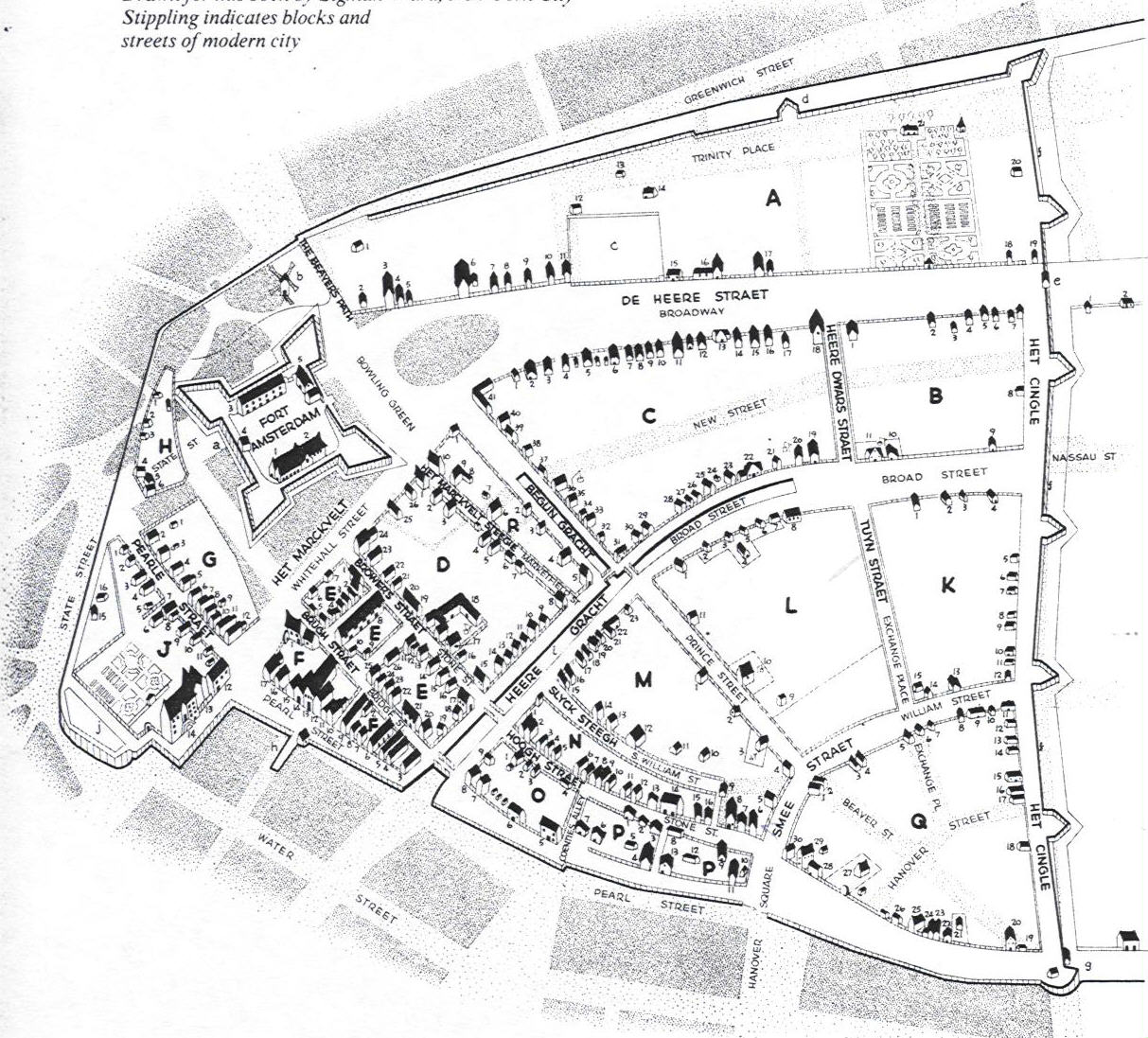
Map of New Amsterdam at
Time of Hans Hansen Bergen and Sarah Rapelje
Interpreting this statement very broadly, a secret expedition was carried out, in which three Indians were killed and two wagonloads of corn were stolen. As a consequence, the Long Island Indians did form an alliance with the River Indians against all the Dutch settlements. The settlements were destroyed and the settlers had to flee to New Amsterdam for protection. Not until spring of the following year, when the Indians were preparing to plant corn, did peace return.
On March 30, 1647, Hans received a patent for land on Long Island near Newtown, adjoining that of his father-in-law, Joris Rapelje and his brother-in-law, Remmert Jansen Vanderbeek. (Relatives grouped together in the same area so they could help one another.) Hans probably was in possession of his land prior to the patent because, as early as 1640, the patent for land received by Abraham Rycken mentions that the land is bounded by that of Hans Hansen.
According to family tradition, while cultivating his plantation, Hans was chased by Indians and hastily climbed a tree. When he was discovered by the Indians and thought his last hours on earth were near, he began to sing in a very melodious voice the Dutch version of "In my greatest need, O Lord." The Indians were charmed by the beauty of his voice and allowed him to go on rejoicing. Supposedly, this proves that "music hath charms to soothe the savage beast."
According to the records of the Protestant Reformed Church in New York, Hans and his wife Sarah Rapelje had the following children:
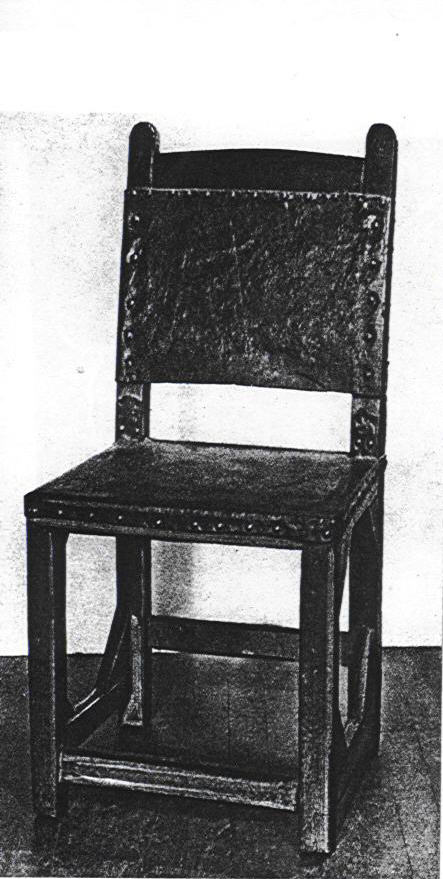
Walnut chair belonged to Sarah Rapalje
Now property of Museum
of the City of New York
Dirck Jansen Hoogland was twenty-two years old when he arrived in New Netherlands in 1657. On October 8, 1662, he married Annetje Hans Bergen, widow of Jan Clerq of Midwout. Dirck provided a certificate from Flatbush, N.Y., attesting to the fact that banns had been published there for three weeks prior to the wedding. He had evidently been living in Flatbush where a number who came from Holland in the same year had settled.
On May 26, 1663, Dirck and two of Annetje’s brothers received permission from Governor Stuyvesant to found a new village that came to be known as Bedford. On May 15, 1664, they received patents for the lands -- 20 morgens each, or, approximately 40 acres.
Over the years, Dirck acquired several more plots of land in Flatbush and Bedford. He became known as " Little Dirck" to his fellow Dutchmen, possibly indicating that he was of small stature.
Annetje Hans Bergen died prior to 1677 and Dirck married Annetje Fedden. He probably lived to be at least ninety-eight years old because his son Jan stated in a deed in 1721 that his father "now lives" on the property. Dirck was the father of at least eight children, the first three by his first wife. A record in the Flatbush Church shows that one of his daughters died in 1706 and he paid 6 guilders for a shroud for her.
His children were as follows:
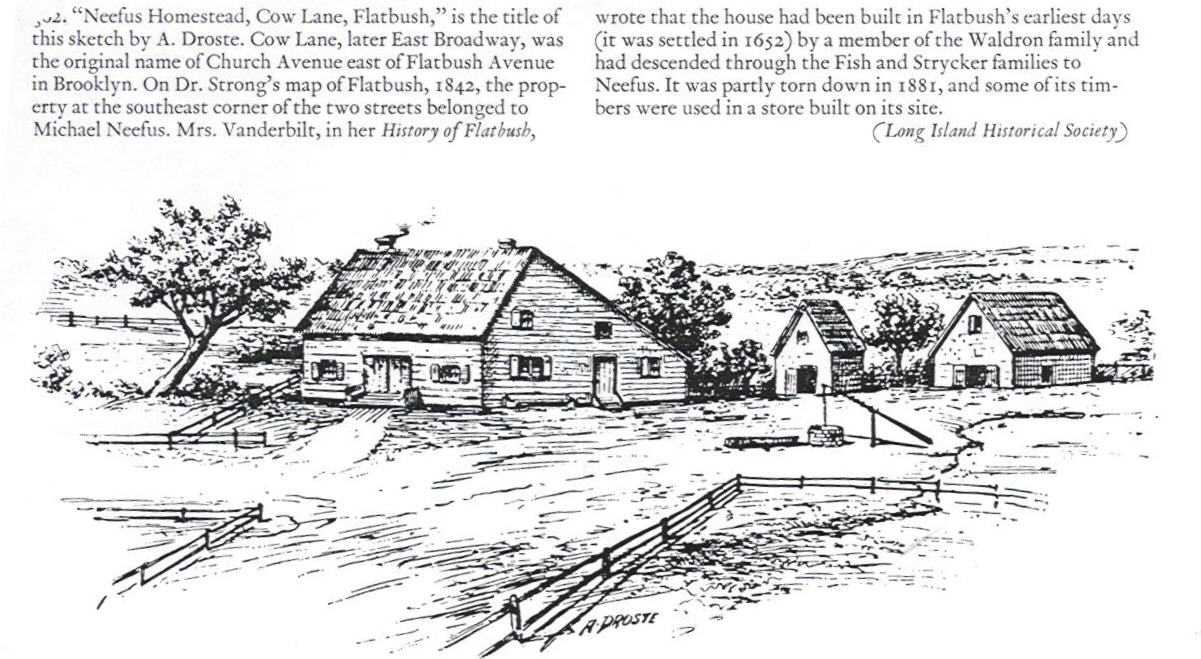
Jan, the oldest son, was probably born at Bedford, Long Island in 1666, before his father moved to Flatbush. He supposedly lived on his share of the property owned by his father until after 1698. In 1687, he, his father, and brother Willem with other Dutch settlers of Flatbush took an oath of allegiance to the English king -- required because Governor Donegan feared war with the French Canadians and distrusted the Dutch support.
The Dutch had been forced to surrender New Amsterdam to the English on September 8, 1664. The names of New Amsterdam and New Netherland were changed to New York, and Fort Orange became Albany, in honor of James, Duke of York and Albany, to whom King Charles II had granted the province of New Netherland. Under the terms of surrender, Dutch land titles were confirmed and a certain amount of religious tolerance was allowed. The Dutch recaptured New York in 1673, but returned it to the English under the Treaty of Westminster in 1674.
Because of its strategic location, New York was involved in the various wars between Great Britain and France in North America. In 1688, Dirck Jansen provided two horses for Governor Donegon’s expedition to Albany. Jan petitioned to be discharged from his bond with regard to being a trooper in the expedition to Albany. He petitioned again in 1692; then on August 7, 1706, he was ordered to help cut sods for fortifications.
Sometime prior to 1690, Jan married Jacoba Ryerse, who in some way was related to Adrian Ryerse and his wife, Annetje Schenck, but there is no proof to indicate that she was their daughter. Adrian and his brother, Martin, emigrated from Holland to Flatbush, Long Island in 1646. Adrian became one of the leading citizens of Flatbush. His wife Annetje Schenck was a descendant of an old and noble family of Holland.
Jan and Jacoba had the following children:
* Editor's Note: Here is the common ancestor for the families that moved to the East Canton area of
Bradford County in the early 19th century and those who stayed behind in the Philadelphia area. In 1892, Isaac Hogeland married Louella Wright in
Canton, PA. the line of descent is as follows:
Daniel Hoagland, born in 1738--his brother Jacobus ("James") was the ancestor of the East Canton families shown in Lyle
Rockwell's history (see link at head of this page)
Derrick Daniel Hoagland, born in 1762
Abraham Derrick Hoagland (Hogeland), born in 1793, married Mary Ann Fenton
Elias Hoagland (Hogeland), 1829-1917, m. Elizabeth VanArsdale
Isaac Hogeland, m. Louella Wright
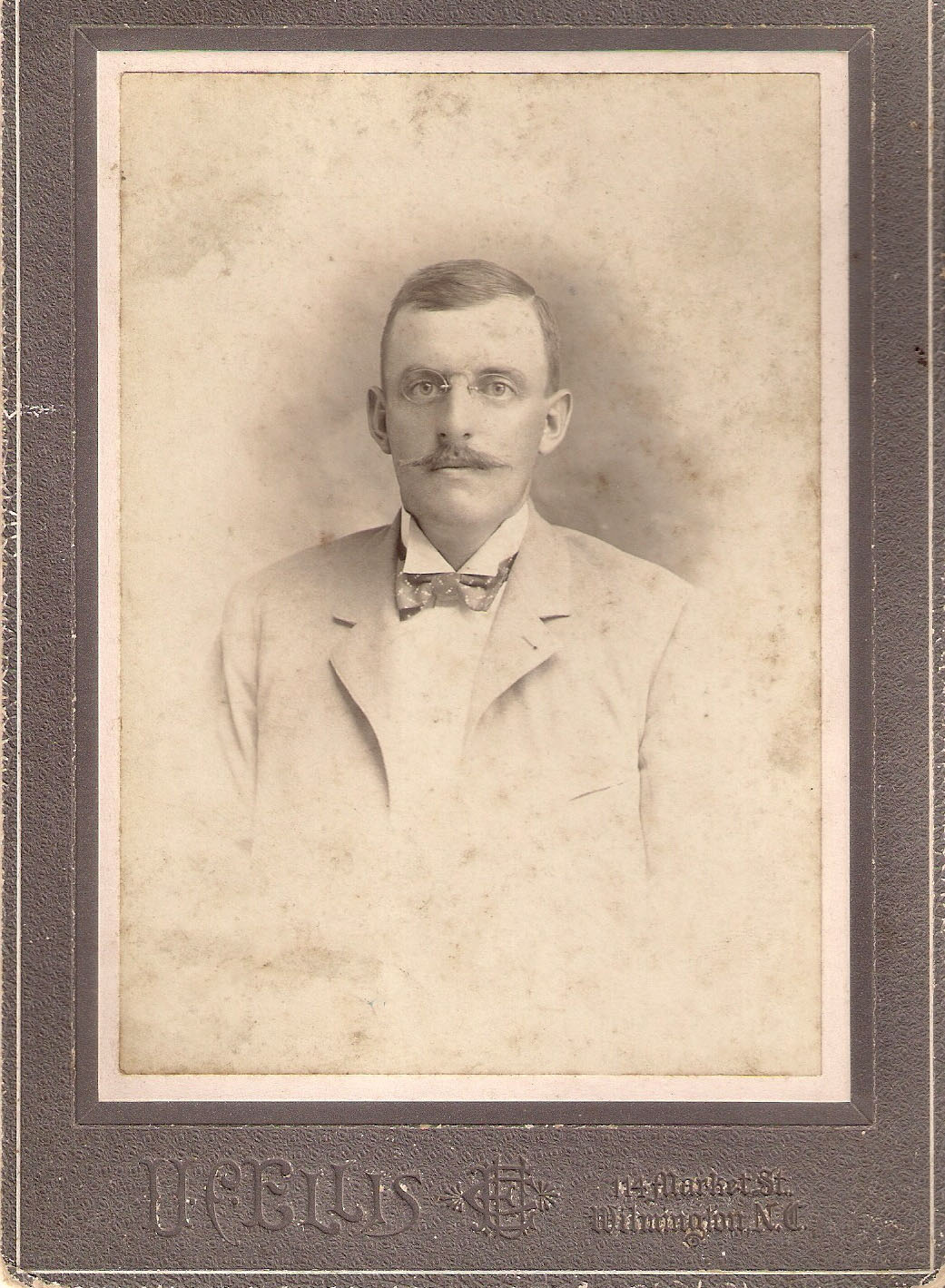
Isaac Hogeland (August 26, 1866-December 4, 1942)
Son of Elias and Elizabeth (VanArsdale) Hogeland ("Hoagland")
Photo Taken in Wilmington, NC
Where He was Living About 1900
Photo Courtesy of Audrey Campbell Watkins
Thanks to Lynn Franklin, we have acquired further information about the Wrights and this Hoagland family from census records. Isaac's Death Certificate shows that he was born and died in Southampton, Bucks County, PA. We know from census information that he and Louella lived with their children in North Carolina (1900), New Jersey (1905) and Chester County, Pennsylvania (1910) at different times, but eventually returned to Bucks County. He and Louella are buried there. They had several children: Anne E., Justus M., Donald R. and Elias W. up through 1910. Here is a photo of daughter Anne with her "Wright" cousins, taken around 1900 in Canton, PA:
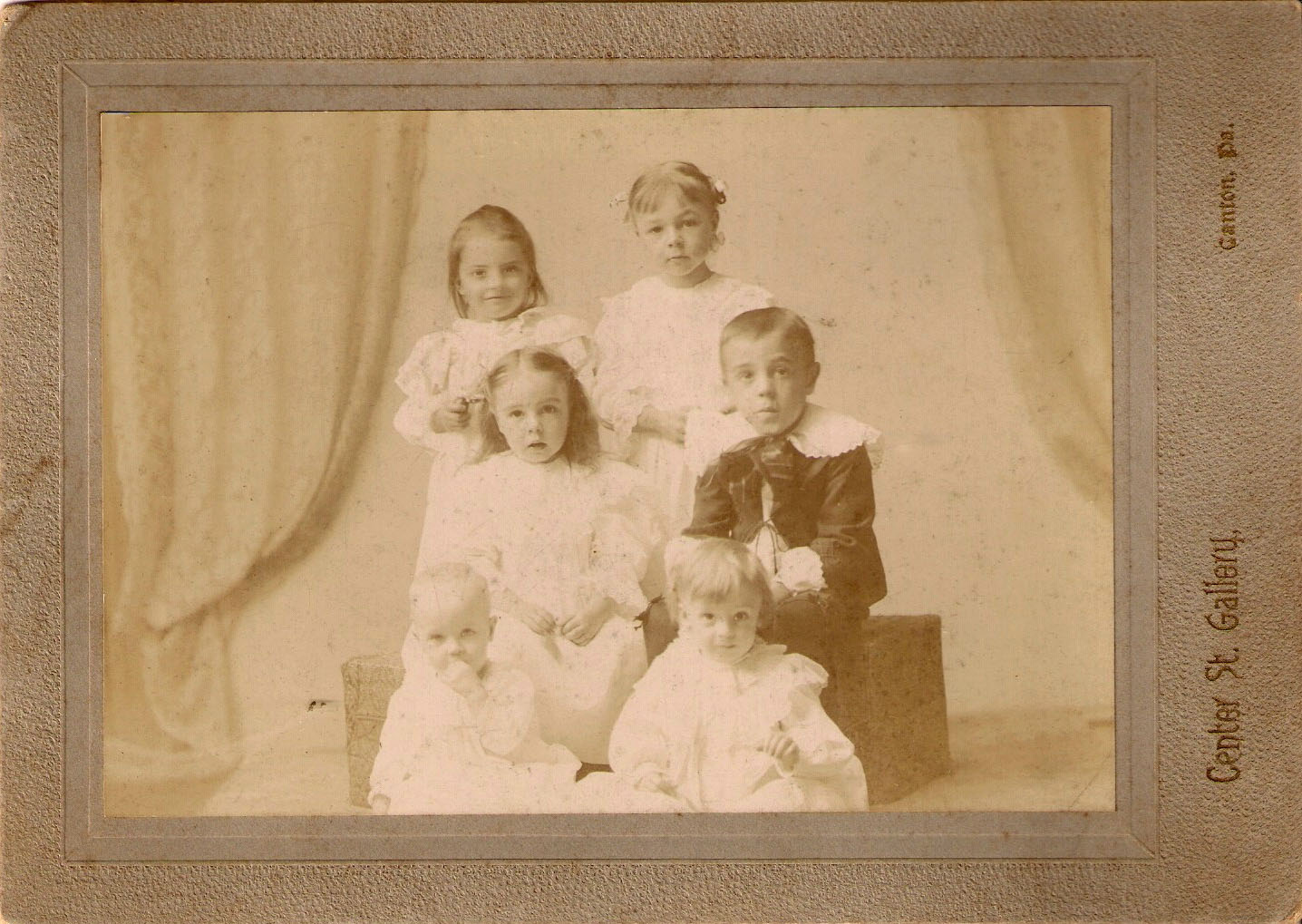
Children of the Wright Sisters
Taken About 1900
Canton, PA
Anne E. Hoagland is top left in the photo
Others: Top right: Allie ("Ollie") Wetherbee, daughter of George and Lottie (Wright ) Wetherbee
Middle row: Maud and Paul Griswold, children
of Harlan and Lelia (Wright) Griswold
Children at Bottom Unidentified
Photo Courtesy of Audrey Campbell Watkins
Louella Wright, wife of Isaac Hoagland, was one of three sisters born to John R. and Ann E. (Williams) Wright in Grover, PA. Ann died three months after giving birth to Louella in 1873, then John remarried to Ellen M. (Holcomb). Louella (May 25, 1873-December 25, 1960) is buried in Southampton, PA with her husband Isaac, as shown on her Death Certificate. Isaac and Louella, according to a family history written by several of their grandchildren, owned a large farm in Huntington Valley, PA, but moved to nearby Southampton after the Depression. He was a farmr, butcher and cabinet maker. She was a housewife with a passion for gardening. Here is a photo of the three Wright sisters, probably taken in the 1890s.:

The Wright Sisters
Daughters of John R. and Ann E. (Williams) Wright
Taken in Canton, PA
L to r: Lottie, Louella and Lelia
Photo Courtesy of Audrey Campbell Watkins
In 1714, Jan purchased property in Freehold, Monmouth Co., N.J. By 1719, he had moved close to New Brunswick, N.J. Two years later, he lived in Raritan, Middlesex Co., N.J. and had sold the land received from his father to his brother Willem, for twenty-five pounds. By 1741, Jan was living in Amwell, Hunterdon Co., N.J., where he probably died prior to 1765. In the 1765 will of son Derrick, provisions were made for Jacoba, his elderly mother.
About 1717, Derrick married Mary, who may have been a member of the Van Kirk family of Flatbush. In 1721, they moved from Raritan, N.J. to an area along the Millstone River in Somerset Co., N.J. On March 2, 1741, he purchased 278 acres at Amwell, N.J., which he eventually deeded to two of his sons, William and Jacobus (James).
In Amwell, Derrick ran a public house. Family tradition claims that there were always "at least two generations of Hooglands under its roof and that from its doors none ever went away hungry." Derrick was the first to be appointed elder of the Amwell Presbyterian Church. He died sometime between August 21, 1765 – the date of his will – and October 5, 1765, when it was probated. Mary died in 1793.
Derrick and Mary had the following children:
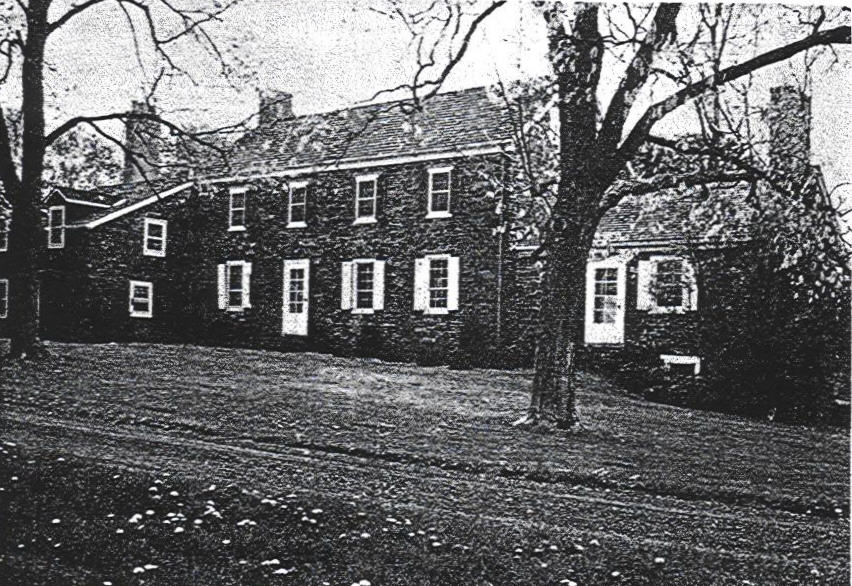
Derrick Hoagland’s Home in Hunterdon, NJ
House
located on Rte. 179 was owned in 1976 by Mr. & Mrs.Robert Schmidt
Source:
A History of East Amwell, 1700-1800
East Amwell Bicentennial
Committee, 2nd edition, page 46, Flemington, NJ
Hunterdon County Historical
Society, 1979
Jacobus (James) was baptized at the Dutch Reformed Church in New Brunswick, N.J. on December 7, 1722. About 1747, he married Mary Newman. In 1760 he sold to his brother William the land which he had received from his father. It is believed that he moved to Bucks Co., PA. Letters of administration for his estate were issued to Mary on October 30, 1770 in Sussex Co., N.J.; Samuel Carpenter and Henry Vanover of Hardwick Township, Sussex Co., N.J. were fellow bondsmen for the estate worth 81 pounds, 19 pence, 8 shillings.
The following are probably the children of James and Mary:
Joseph Hoagland was born July 23, 1754 in Amwell, Hunterdon Co., N.J. Around 1772, he married Hannah Carpenter, the daughter of Samuel and Elizabeth Carpenter. Joseph’s brother Amos had married Ruth, Hannah’s sister.
As early as 1774, Joseph’s name appears on the tax list for Muncy, Lycoming County (now Sullivan County), PA. By 1777, Joseph and his family had settled in Indian territory on the west side of Lycoming Creek. In fact, there is evidence that Joseph and family were in the area as early as 1774. What you see below is a copy of the 1774 survey showing Joseph Hoagland's property (Hogland's Improvement) above John Carpenter's land in the Muncy area of current Lycoming County, PA, then part of Northumberland County. Joseph and his family lived there before settling later in Shunk in Sullivan County, PA. A friend of Kathy Heilman who is curator of the Muncy Historical Society was able to purchase the original survey at auction for her. She made a copy and gave the original to the Society where it is currently located.

Joseph Hoagland's Improvement
Muncy Area
1774
Note: The Hoagland land is labeled upside down in the handwritten record as
"Hoagland's Impt".
The second item is a surveyor's map of the tracts of Muncy Township, Lycoming County, PA. This land is in the Pennsdale area, purchased by Joseph and Hannah Carpenter Hoagland, and Amos and Susannah Carpenter Hoagland, in 1794. Unfortunately, the map is not a great copy. The original must have had some water damage and the text is blurred. The accompanying description reads as follows:
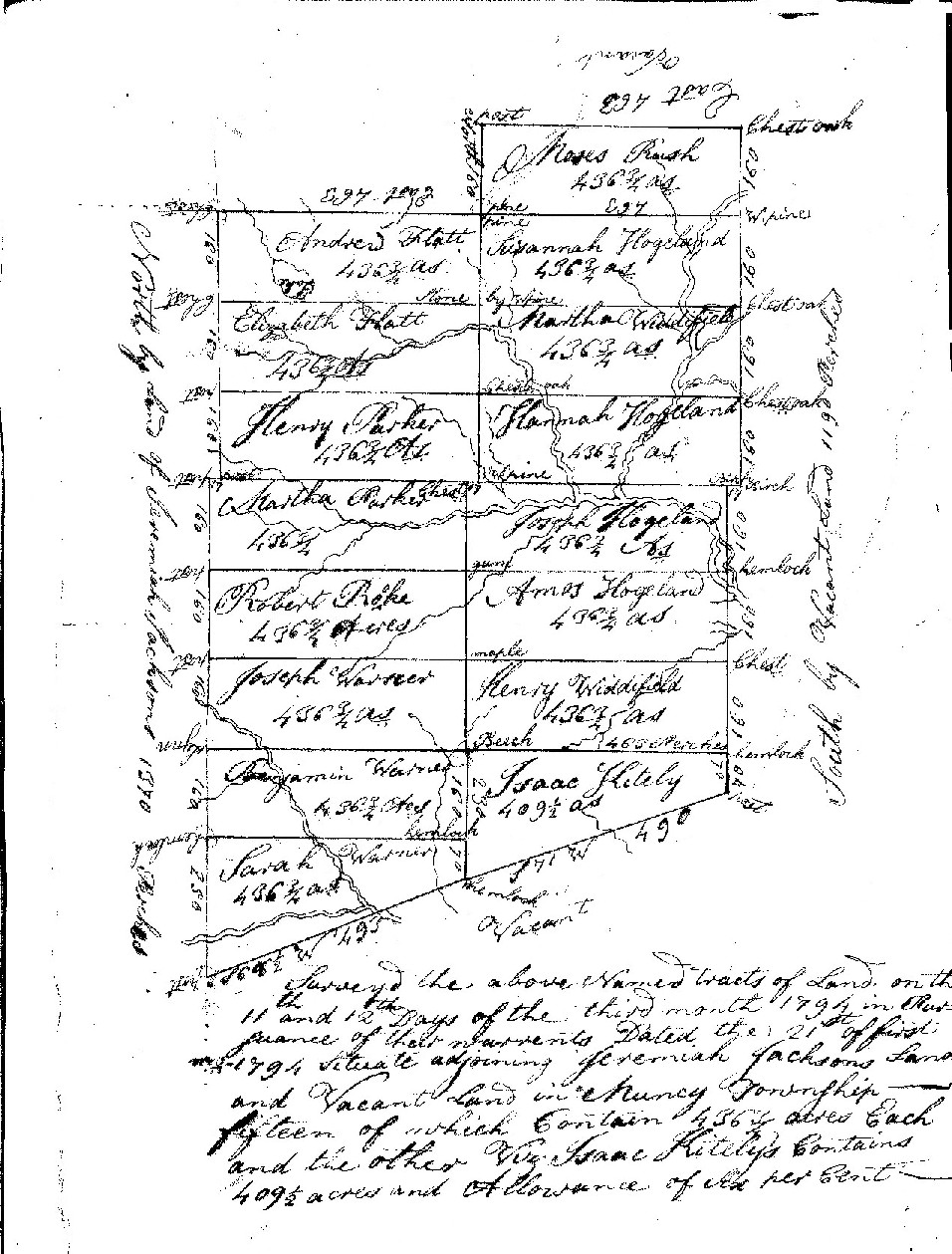
The Hoagland Tract
Surveyor's Map of the Muncy Area
1774
A descendant of Joseph recounted the following family tradition:
My grandfather Joseph’s father, my great-grandfather, was also Joseph; of course you can see, he was my great-grandfather, as I just said … He lived in this state at a place which afterwards was called Hoagland Run. It was at the time of the Revolutionary War … While at this point, the Indians lived all around them. Perhaps, you know that the British hired the Indians to scalp the white people, and paid them so much for the scalps. That is the way they took to get rid of the white people. One of the Indians had become quite friendly with my great-grandfather which I am telling you about because they had befriended him. So one day this Indian told Great-Grandfather that the Indians had set a time at which they were going to scalp all of the white people. Joseph came to the house and told his wife that it would be a good time to visit her parents who lived in Muncy, PA. It was forty miles away. It was on a Monday and she had done her washing. He did not want to tell her at first because she was nervous and he did not want to frighten her by telling her what the Indian had told him. So he said he would have to make it plainer or more direct. He said, "I’m afraid the Indians are going to make trouble." Then she said, of course, they had better go. They then buried their cooking utensils and tied up their bedclothes in a sheet and carried them and the little child or perhaps led the child part of the way for she was about four years old. They had no mode of transportation so they had to make the distance on foot.
The story may not be very accurate. Joseph and Hannah would have had at least two, if not three, children at that time. By the 10th of June, 1778, Joseph was at Muncy, as evidenced by the appearance of his signature on a petition requesting the Executive Council to provide assistance against the Indians. The signatures of Samuel Carpenter, Joseph Carpenter, Amos Hoagland and John Carpenter also appeared on the petition. Amos Hyland, Joseph Hyland, John Carpenter and a Mary Hoagland appear in the Muncy Township assessment list for early 1778.
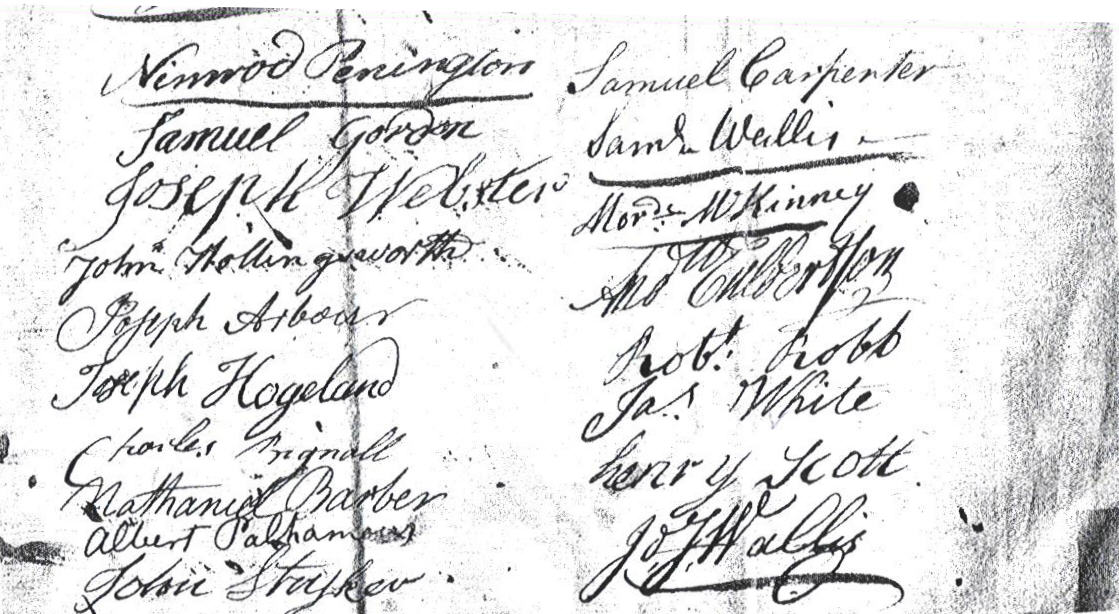
In continuation of the previous story, another source indicates that Joseph and his family took refuge in Wallis’ Fort upon arrival at Muncy. Joseph, a weaver by trade, supported his family by weaving during the day and well into the night when he worked by the light of pine roots. When he became tired, he would lie down on the loom bench, rest for a short time, then start again.
At the time of the Great Runaway, Joseph, his family and the Carpenters settled in Maiden Creek Township, Berks Co. and lived there until the end of the war. Joseph continued to support his family by weaving. Joseph’s brother Amos moved his family back to Sussex Co., N.J. and never returned to Pennsylvania.
At the end of the war, Joseph with his family and the Carpenters returned to Muncy. If any squatter could prove settlement prior to 1780 on land located between Lycoming Creek and Pine Creek, he could submit a preemption application for purchase. The applications were limited to 300 acres, with the purchase price to be paid no later than May 1, 1785. Joseph never returned to his land on the west side of Lycoming Creek but agreed to sell the property to John Hays of Berks Co. On July 16, 1785, Joseph received from Hays 39 pounds, 18 shillings and four pence for the land; two days later the deed was recorded. On August 12, 1785, Hays submitted a preemption application which reads as follows:
The log cabin that John Hays built near Hoagland’s Run still stands near the Perryville Bridge along Route 973 in Cogan Station. It was built the year the land was acquired. An historical marker announces that the cabin was built in 1780, but John Hays didn’t acquire the land until 1785.
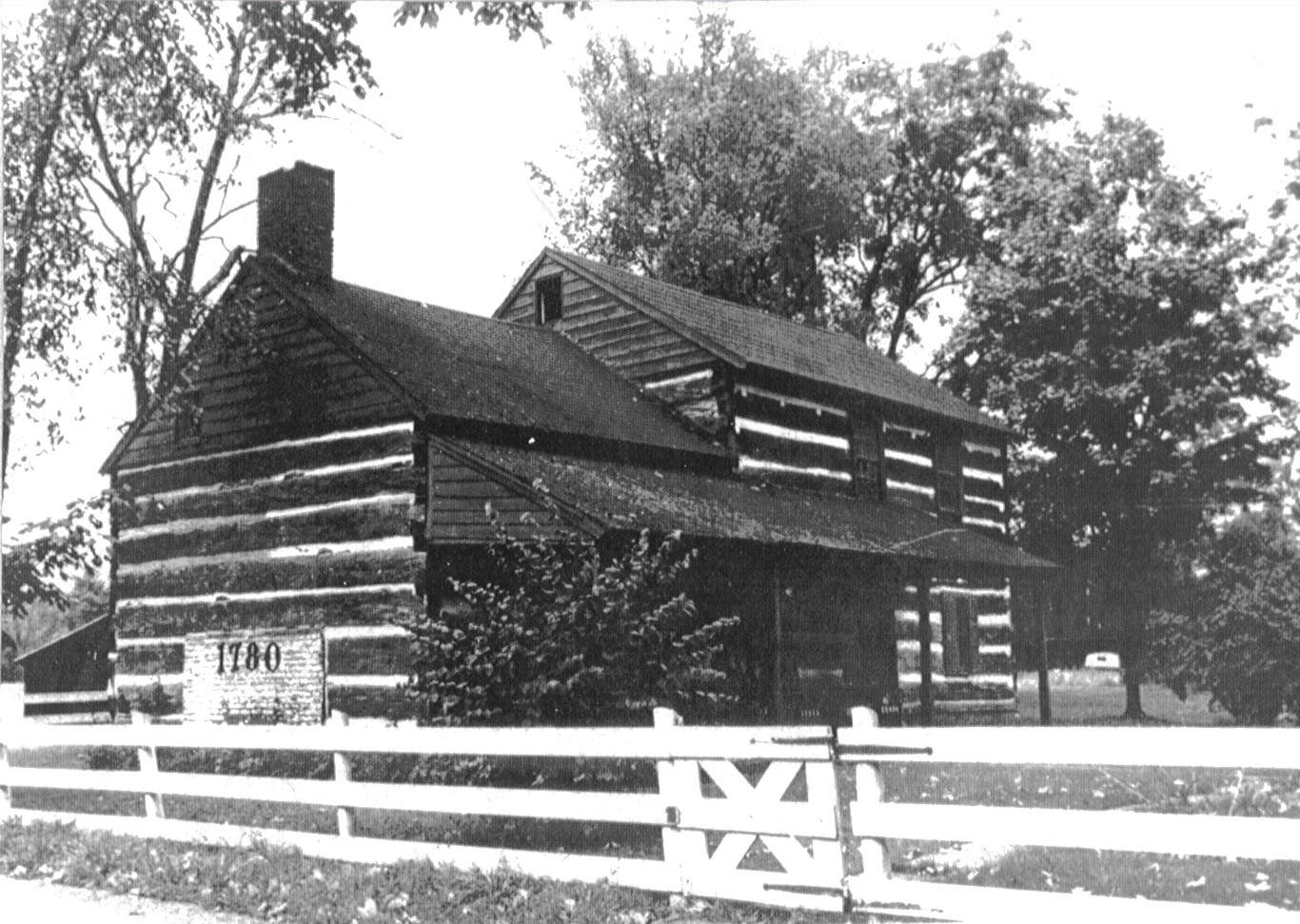
In the 1787 tax records for Northumberland County, Joseph appears as owning no acreage, but 2 horses and 2 cows. According to the Pennsylvania Archives, Joseph received a warrant for 200 acres on October 24, 1792; then, Joseph and Hannah each received warrants for 400 acres in Muncy on January 21, 1794, but never received the patents. John Carpenter, Enos Lundy and Rachel Carpenter Lundy, and Joseph Carpenter owned land at present-day Pennsdale. Joseph Carpenter’s land included the three acres that he and his wife deeded in 1797 to trustees as the site for a Friend’s Meeting House and burial ground.
North of the Carpenter and Lundy properties from the crest of the hills, was the forest area known as " Hoagland Improvement." Joseph and his sons logged the area and carried the logs out by sled.
Joseph’s name appears in the day book of the Muncy Farms for purchases charged either "at the store, mill and farm", or "counter-charges for services, such as spinning, weaving, carpentry, surveying, farm labor, connected with the conduct of a large estate."
In 1800 an Englishman named Phineas Bond purchased a large tract of land in present-day Sullivan County. He offered 100 acres of land to the first twelve families who would settle there and an additional 300 acres to anyone who would erect a grist mill on the land. Within one year of settlement, a substantial log house had to be built and, within five years, ten acres had to be cleared and improved. Only one family was allowed to settle on a tract - - 400 acres - - and could buy the additional 300 acres at $2.50 per acre. Joseph and his sons were among the first twelve to apply for the grant; Joseph agreed to build a grist mill to obtain the grant for an additional 300 acres.
In 1802 or 1803, Joseph Hoagland moved with his family to Fox Center, Fox Township, in present-day Sullivan County. They loaded their goods on a wood-shod sled drawn by a yoke of oxen, and traveled up the Genesee Road from Muncy over the mountains to Huntersville, by Highland Lake, on to Loyalsock, up Elk Creek to Lincoln Falls, and finally to Fox Center - - present-day Shunk. For approximately ten miles, there were no roads and they had to cut the brush and trees as they traveled.
In May, 1803 Joseph signed a petition requesting that the Genesee Road be improved for public travel from Muncy to the Genesee lake country. The Genesee Road was the road that Joseph and his family followed before cutting their way overland to Shunk. The road continued on through Eldredsville to Towanda and New York. The road to Shunk veered off to the left from the Genesee Road above Lincoln Falls.
Below where the present-day bridge crosses the Hoagland Branch at Shunk, Joseph built a crude log grist mill. According to an account by W. H. Egle:
Sources indicate that Joseph and Hannah joined the Quaker Church in 1804. Since, prior to that date, Hannah’s family was extremely involved with the Quaker Meeting House in Maiden Creek Township and Pennsdale, it is difficult to believe that they weren’t members earlier. One account indicates that religious meetings were held by the Quakers at Joseph Hoagland’s home when the area was first settled.
Meetings were held in private homes until 1828 when a log meeting house was erected northwest of Eldredsville in Elkland Township. This log structure was a "one story building containing two windows and a door with clumsy stone chimney and fire place for warming;" it was used until 1850.
Joseph and Hannah had the following children:
** Editor's Note: You will note the Battin family introduced in the preceding paragraph. Through this family, the Hoaglands would become intermarried with several other original families in the area. You can learn more about one such example at The Frey Lineage from Joseph Hoagland and Hannah Carpenter. This line was descended from Marshall and Mary B. (Hoagland) Battin.
On February 28, 1835, Joseph Hoagland, the elder, wrote his will in which he agreed to bequeath all his personal property and real estate to his son Jonathan, who, in return, would support him for the remainder of his life and pay his funeral expenses. Since his wife Hannah is not mentioned, she probably had died earlier. He died December 4, 1845. Joseph and Hannah are buried in unmarked graves in the old Quaker cemetery on the hill above Hoagland’s Branch at Shunk. Two years later in 1847, Sullivan County was organized with fewer than fifty taxable individuals living in Fox Township.
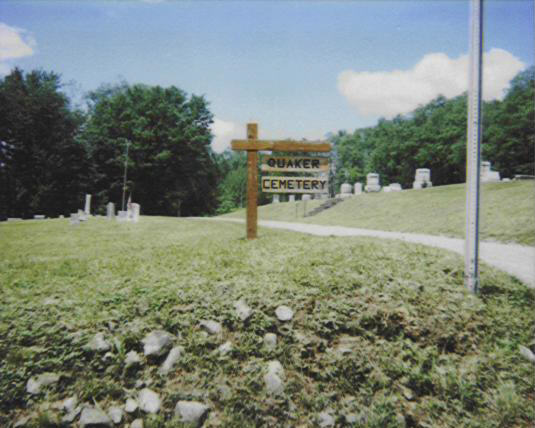
Old Quaker Cemetery, Shunk, PA
In April 2001, Gloria Wilson provided to the Sullivan County Genealogical Web Site a further historical lineage of the Hoagland family that descends through Joseph, the younger, the son of Joseph Hoagland and Hannah Carpenter. Gloria's great-grandmother was Rosa Dell Hoagland, born in PA in 1872. She married William Thomas Keating and her daughter (Gloria's grandmother), Nina Doris Keating, was born in 1910 and raised in Fox Township in Sullivan County. Through her father and grandfather, and by reference to a filmed Bible at her local LDS Family History Center, Gloria was able to come up with the following extended genealogy. We are grateful to Gloria for her assistance.
Joseph Hoagland (b. 1784) m. Hannah Mullen. Their children were:
Samuel Hoagland m. Sarah Sally Wilcox (1823-1878) and they had the
following children:
Lewis Hoagland and Eliza Agnes Teevan had the following children:
Nina Doris Keating and Edward Earl Wilson had the following
children:
Earl Edward Wilson m. Joy ______ and their daughter is Jennifer Lynn Wilson, b. 1974; Earl later married Sandra Baker and their children are Rebecca Ilene Wilson, b. 1981, and Donald Earl Wilson, b. 1983
Hannah Elizabeth Hoagland (1847-1937) m. James Hamm Campbell (1831-1911) and
they had the following children:
Joseph Hoagland and Hannah Carpenter Hoagland passed through here two hundred years ago, as evidenced by Hoagland’s Run at Perryville and Hoagland’s Branch at Shunk. Not much is known about his personal life, but what information does exist reveals a rugged individual who was a pioneer in every sense of the word. Few residents of the Hoagland surname live in this area today, but many of those with the surname Higley, Mullen, Shaffer and Heilman are direct descendants of Joseph Hoagland.
BIBLIOGRAPHY
Abstracts, Lycoming County wills. Book A.p. 77.
Administration of estate, James Hoagland, Sussex Co., N.J., October 30, 1770.
Annals of Newton. pp. 266-269.
Bailey RF: Dutch systems in family naming: New York and New Jersey, Pt. I. National Genealogical Society Quarterly, 1953, Mar;41(1):1-11.
Bailey, RF: Dutch systems in family naming: New York and New Jersey. Pt., II. National Genealogical Society Quarterly, 1953, Dec;41(4):109-18.
The Bergen Family: descendants of Hans Hansen Bergen: early settlers of New York … Albany N.Y., Joel Munsen, 1876.
Burial records of Muncy Monthly Meeting of Friends, Lycoming County in Pennsylvania, established tenth month, 23rd day, 1799 / compiled by John E. Eshelman. Philadelphia, Pennsylvania Genealogical Society, 1946.
Carpenter DH: History and genealogy of the Hoagland family in America from their first settlement at New Amsterdam, 1638 to 1891. New York, Cornelius N. Hoagland, 1891.
Day book of "Muncy Farm." Now and Then 1932;4(10):307.
Dilliard ME: An album of New Netherland. New York, Twayne Publishers, 1963.
Dutch system in family naming: corrections to Part I. National Genealogical Society Quarterly, 1953 Sep;41(3):98.
Egle WH: Notes and queries : historical and genealogical. Harrisburg Telegraph, 1895. v. 2, 4th series. pp. 30, 189, 197, 274-7, 309-11, 324, 326.
The Elklands. Now and Then 1930; 4(5):168-72.
Genesee Road surveyor’s maps.
Godcharles, Frederic A.: Chronicles of Central Pennsylvania. Lewis Historical Publishing Co., 1944. v. 3. p. 410.
Hechtlinger, A, & Tunnel, D: Life in New Amsterdam. Pt. I. Early American Life, 1974, Feb:17-25
Hechtlinger, A, Tunnel, D: Life in New Amsterdam. Pt. II. Early American Life, 1974, Apr:15-9.
Historic Lycoming County: Capt. John Hays slept here. The Grit, 19 Sept 1982.
Historical map: Sullivan County. Towanda, Pa., L.E. Wilt, 1944, reproduced on Sullivan County Genealogical Project Web Site: www.rootsweb.com/~pasulliv.
History of Lycoming County, Pennsylvania : including its aboriginal history: the colonial and Revolutionary periods; early settlement and subbsequent growth; organization and civil administration; the legal and medical professions; internal improvements; past and present history of Williamsport; manufacturing and lumber interests; religious, educational and social development; geology and agriculture; military record; sketches of boroughs, townships, and villages; portraits and biographies of pioneers and representative citizens, etc., etc. Baltimore, Gateway Press, 1990.
Hoagland, EC: Twigs from family trees : or, 162 early American and foreign lineages of first settlers in this country and their descendants who were pioneers in northern Pennsylvania and central New York together with royal lineages, Revolutionary journals, incidents and anecdotes of the old timers. And a register of the marriages and deaths of the pioneers. Wysox, Pa., The Author, 1940.
Hoagland GW: Dirck Jansen Hoogland family history, 1657-1976. Shaker Heights Ohio, The Author, 1976.
Kouwenhoven JA: The Columbia historical portrait of New York : an essay in graphic history in honor of the Tricentennial of New York City and the Bicentennial of Columbia University. New York, Doubleday, 1953.
Last will and testament of Joseph Hoagland, February 28, 1835.
Munger DB: Pennsylvania land records : a history and guide for research. Wilmington, Del., Scholarly Resources, 1991. pp. 153-155.
New Jersey colonial documents : calendar of wills, 1761-1770.
Northumberland Co., Pa. Deed book C, p. 117. Joseph Hoagland to John Hayes.
On the Genesee Road : an early pioneer post-road out of Muncy Valley, leading to the Genesee Valley in Western New York. Now and Then. 1936;5:120-40.
Pennsdale Meeting House records
Pennsylvania Archives. 3rd series, v. 19. p. 782.
Pennsylvania Archives. 3rd series. v. 25. p. 170, 176, 182.
Preemption application, John Hays, August 12, 1785.
Preemption application, James Kyle, Jr. and William Kyle, October 20, 1785.
Rogers FM: The first permanent settlers of the upper Loyalsock. Now and Then, 1943, Oct;7(7):153-160, 173-7.
Russell HH: The Great Runaway of 1778. Northumberland County Historical Society Proceedings, 1960, Oct 1;23:1-16.
Ryerson AW: The Ryerson genealogy : genealogy and history of the Knickerbocker families of Ryerson, Ryerse, Ryerss; also Adriance and Martense families; all descendants of Martin and Adriaen Reyersz (Reyerszen), of Amsterdam, Holland. Chicago, Edward L. Ryerson, 1916.
Streby G: History of Sullivan County, Pennsylvania. Sullivan Gazette Printing, 1903.
Theiss LE: How the Quakers came to central Pennsylvania.
Northumberland County Historical Society Proceedings, 1957;21:67-77.
Wabeke BH: Dutch emigration to North America, 1624-1860. New York, Netherlands Information Bureau, 1944.
Whitacre ME: Friends’ influence on the early settlement of Muncy Valley.
Now and Then, 1941, Oct; 6(12):329-37.
Copyright © 2001 Robert E. Sweeney and individual Contributors. All Rights Reserved. Prior written permission is required from Robert E. Sweeney and individual Contributors before this material can be printed or otherwise copied, displayed or distributed in any form. This is a FREE genealogy site sponsored through PAGenWeb and can be reached directly at ~Sullivan County Genealogy Project (http://www.rootsweb.com/~pasulliv)
Back to the Settlers Page